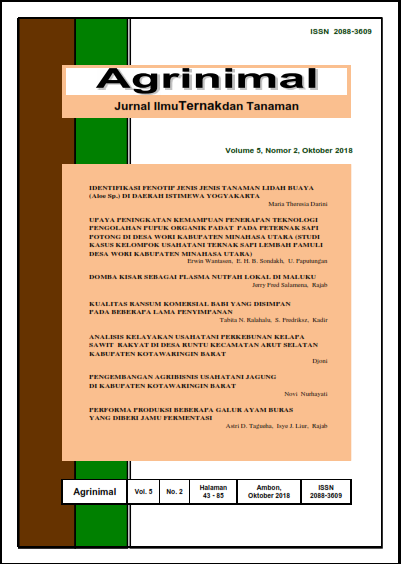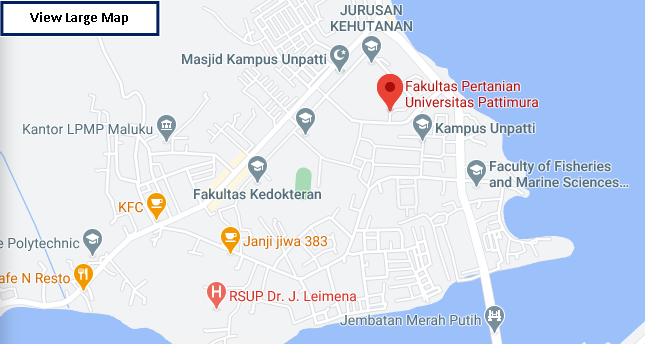IDENTIFIKASI FENOTIP JENIS JENIS TANAMAN LIDAH BUAYA (Aloe Sp.) DI DAERAH ISTIMEWA YOGYAKARTA
Abstract
The study aims to determine the types, population, frequency and dominance Aloe Sp. plant has been conducted in Yogyakarta, from March to September 2012. Research carried out by the method of vegetation analysis through surveys and sampling of the Aloe Sp. plant locations, districts in the regency in the province of Yogyakarta Special Teritorial. To determine the types of Aloe Sp. plants using descriptions that are tailored to the identification of key observations dichotomi.Variabel method includes types - types of plants, frequency distribution, and plant dominance. Analysis of variance real level of 5%, in order to know the real difference between the district / sub-district results showed that in Yogyakarta found three (3) types of plants are: Aloe ferox Mill, Aloe vera L. and Aloe barbadensis. Highest population in both counties is Aloe vera and province. While the lowest population is Aloe barbedensis . Frequency spread between the types of Aloe vera L.and Aloe ferox Mill equal 100%, while Aloe barbadensis least 80%. Highest dominance of this type of Aloe vera L.
Downloads
References
Akinyele, B. O. & A. C. Odiye. 2007. Comparative Study of Vegetative Morphology and Existing Taxonomic Status of Aloe vera L. Journal of Plant Sceinces 2 (5): 558 – 563.
Anonim. - a. Aloe vera ( Aloeaceae). Global Compedium of Weeds. Aloe vera. http://www.hear.org./gcw/species/aloe-vera. [17/11/2008].
Anonim. 2005. Budidaya Lidah Buaya, Aspek Produksi Sistem Pembiayaan Informasi Lendung Model Usaha Kecil. Pp 1 – 5.
Anonim. 2007. Final Report on Safety Assessment of Aloe Extract. International Journal of Toxicologi 26: 1 – 50. http://www. Inform world.com/smpp/content-db=all?content=10. 1080/1091581070135186. [17/11/2008].
Anonim. 2009. Tanaman Obat Asli Milik Masyarakat Bangsa dan Negara Indonesia. TDA Semarang. http://tdasemarang.blongspot.com.[9/03/2011].
Boudreau, D. & F. A. Beland. 2006. An Evaluasi of The Biological and Toxicological Propertis of Aloe barbadensis Mill, ALOEVERA. Journal of Environmental Science and Health Part C 24 (1): 153-158.
Herlambang, C. H. 2010. Maksimalkan Potensi Obat Tradisional. Kompas.Com. http://www. hileud. com/hileudnews. [10/03/2011].
Jadnika, A. & Saptoningsih, 2009. Meraup Laba dari Lidah Buaya, Budidaya dan Pengolahan. pp 118. AgroMedia Pustaka.
Kane, N. 2007. Aloe for Acid Reflux, you’ve seem aloe juice at the healtfoodstore, now learn how it helps heal acid reflux, also called heart burn. Healt Publication. http://findarticles.com /p/articles/mi-mOFKA/is-4-69/ai-n18791510. [17/11/2007].
Pessarakli, M. 2005. Handbook of Photosynthesis, Second Edition, pp. 386- 394. C. R. E. Press. Taylor Francis Group.
Pujoarinto, A. 1990. Sistematik Tumbuhan. Yogyakarta: Penerbit Yayasan Pembina Fakultas Biologi Universitas Gadjah Mada.
Reynold, T. 2004. Aloes, The Genus Aloe. C.R.C. Press. ISBN. 978- 0415306720.
Salisbury, F. B. & C. W. Roos. 1992. Plant Physiology. Wadsworth. pp. 66 - 90; 266 – 284. Belmont California: Publishing Company Inc.
Solaeman, S. 2005. Model Pengembangan Agribisnis Komoditi Lidah Buaya (Aloe vera L.). pp 1-7. Peneliti pada Deputi Bidang Pengkajian UKMK.
Tjitrosoepomo, G. 1994. Taksonomi Tumbuhan Obat – Obatan. pp: 398 – 406. Yogyakarta: Gadjah Mada University Press.
Triharso. 1994. Dasar Dasar Perlindungan Tanaman. Yogyakarta: Gadjah Mada University Press.








